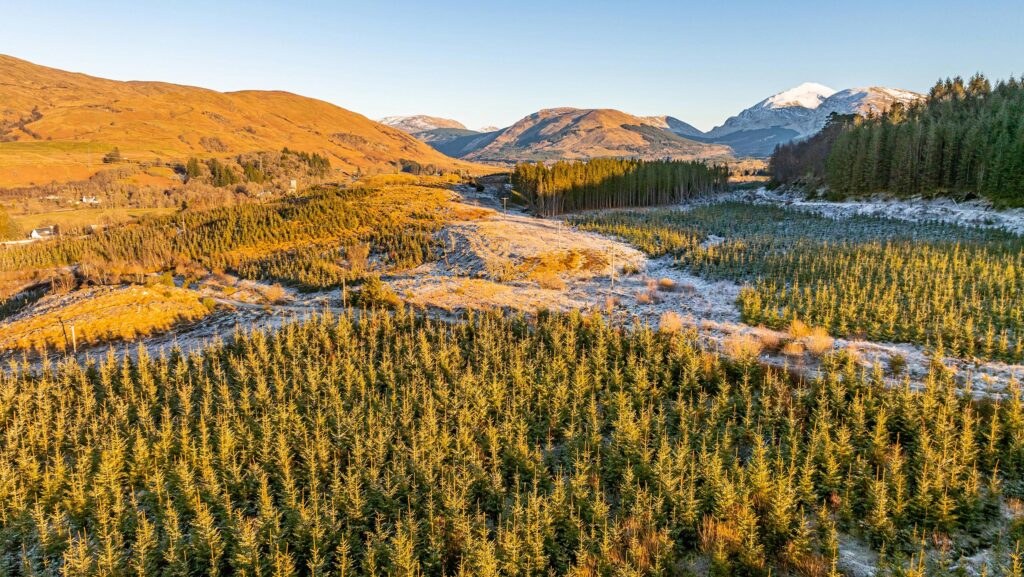Tree planters still outbidding farmers in Scottish uplands
 Dalmally Forest © Strutt & Parker
Dalmally Forest © Strutt & Parker Forestry interests continue to outcompete livestock producers for land, despite a slowdown in that market in recent months.
Agents put average plantable land values in Scotland at about the £4,000/acre mark, down from £6,000/acre at their 2021 peak.
However, they say prices remain more than double 2017 levels, are considerably above the underlying agricultural value in the uplands of northern Britain and are firm.
See also: Farm woodland management holds income potential and other benefits
Easing timber values and pressure from regulation, alongside higher interest rates, are listed as factors for a steadier planting land market.
The value of hill land suitable for tree planting more than quadrupled between 2017 and 2021, according to a Scotland’s Rural College (SRUC) report.
SRUC research fellow Ian Merrell says: “We have found that the initial rush into Scottish land by natural capital investors and companies has started to slow down, but land is increasing at a pace that excludes smaller players from the land market.”
In comparison, the value of marginal lower hill land for grazing is estimated at £1,000 to £2,500/acre by Strutt & Parker.
Simon Hart, head of forestry Scotland for woodland agent John Clegg & Co, gives the following reasons for an easing in prices:
Timber values
Forestry values and planting land are well correlated with timber prices.
Prices have returned to levels seen in 2018 and 2019, following the Covid 19 peak in 2021-22, according to the Forestry Commission standing timber index.
The UK imports about 80% of its timber (much of it from Sweden) and the market is driven by world pricing.
Renewed UK Forestry Standard
Last year the regulations governing commercial timber production (the UK Forestry Standard) were reviewed, the fifth revision since its inception in 1998.
Among the changes were a 10% reduction in area allowed for one species from 75% to 65%, which in northern Britain will limit the area of Sitka spruce, which is generally the most productive species.
Interest rates
The Bank of England base rate of 5.25% is 4.5 percentage points higher than in 2019. This is limiting investment in forestry land somewhat, as a lower risk return can be earned by keeping funds in the bank.
This is influencing non-cash buyers.
General market uncertainty
The cost-of-living crisis and the Ukraine conflict have knocked investment confidence.
Easier market
A survey of forestry market activity by John Clegg & Co reported 2023’s average selling price at 104% of the asking price, compared to 118% in 2022 and 124% for the five-year average.
The average price of standing forestry sold in Great Britain in 2023 was £8,500/acre compared with £10,764/acre in 2021.
Marketing activity also fell last year – 2,200 stocked hectares were traded, almost 80% lower than in 2022 and 76% down on the five-year average.
Outlook
Demand for forestry land remains good and includes private individuals, pension funds and forestry funds, both domestically and from abroad, says Simon.
He predicts the market to move higher in 2024 but says an element of caution will remain as long as higher interest rates persist.
“Globally, demand for timber is forecast to increase substantially and timber use needs to expand to decarbonise the built environment.”
Forest Market Review 2023
- 20 forests were sold in Great Britain during the 2023 calendar year, compared with a five-year-average of 54
- 75% of the land sold was in Scotland
- 60% of the forests sold within six months of being marketed
- Total price of forests sold in 2023 – £45m, compared with five- year average of £161m.
Source: John Clegg & Co
